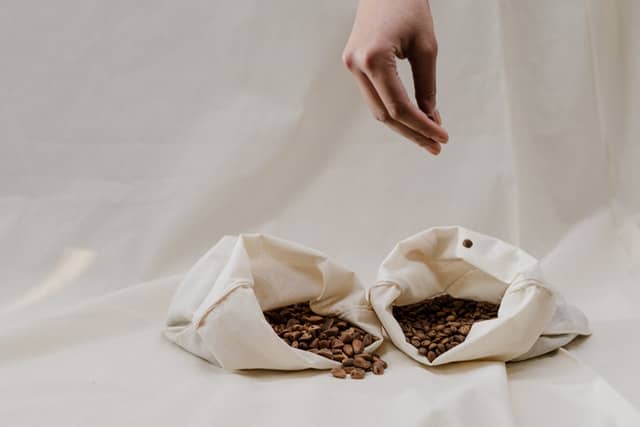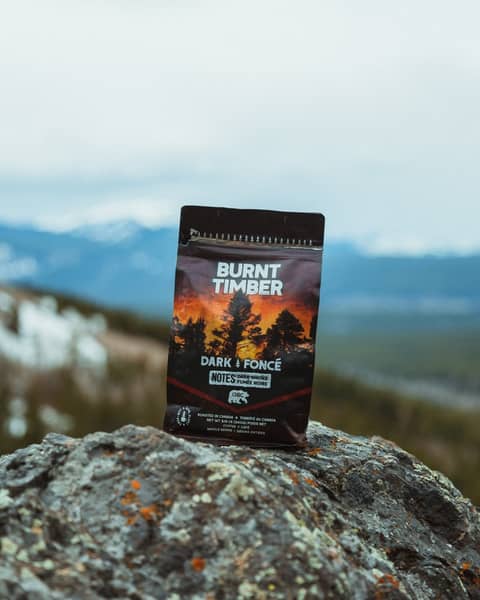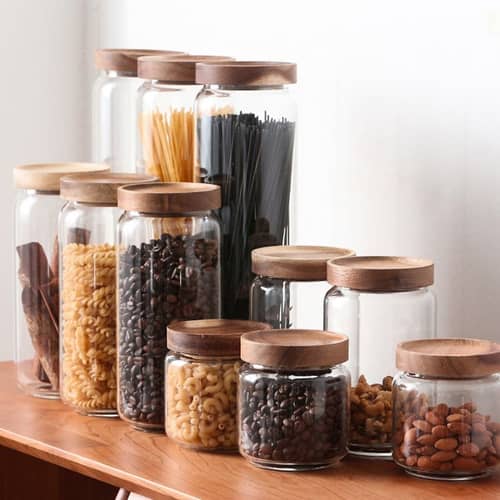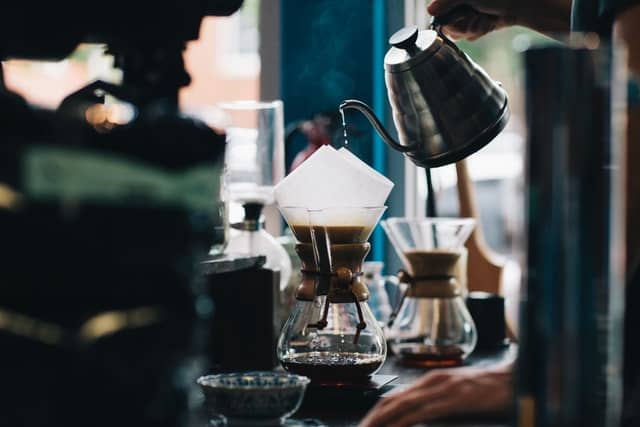You’ve just purchased coffee and wonder how to open coffee bag packaging the right way. You’ve probably also wondered how to reseal the bag so that your coffee retains its freshness.
If that’s the case, we have the answers!
In this blog post, we’ll outline how to open coffee bag packaging and reseal it neatly, to ensure your coffee does not spoil or go stale too quickly, keeping you powered for longer.
But first…
- How Does a Coffee Bag Work? Discover the Secret Behind the Hole in Your Coffee Bag
- How to Open a Bag of Coffee
- How to Reseal a Coffee Bag Properly to Keep Your Coffee Fresh for Longer
- How to Properly Open Vacuum-Sealed Coffee Bags and Reseal Them
- How Long Does Freshly Roasted Coffee Beans Last in the Bag Once Open?
- Storing Coffee To Maximize Its Freshness
- FAQs
- Conclusion: How to Open Coffee Bag Packaging
How Does a Coffee Bag Work? Discover the Secret Behind the Hole in Your Coffee Bag
If you’re a coffee lover like me, you’re probably concerned about keeping your coffee purchases from your local grocery store or Amazon from going bad.
Modern coffee bags have the proper packaging requirements to provide an internal environment that helps coffee grounds or beans retain their freshness.
This way coffee can last for up to 2 weeks at room temperature and 1 month in the freezer once opened.
These special packs mitigate the effects of the coffee roasting process. When you roast fresh coffee, it releases carbon dioxide into the atmosphere slowly during what’s known as the degassing period. Over this period, carbon dioxide gas builds up from coffee inside the bag.
So, how do coffee bags work? Most coffee bags have a hole or valve. This hole or one-way valve in the coffee bag stops internal carbon dioxide buildup from coffee, without which your pack will burst.
However, these one-way valves serve two purposes: apart from allowing internally formed carbon dioxide to escape they also prevent external oxygen from entering inside the bag.
Oxygen is disastrous for coffee; it gradually oxidizes your coffee. Oxidization ruins coffee’s aroma and flavor.
How to Open a Bag of Coffee
There are two main methods for opening a coffee bag at home: using a kitchen scissor or using your bare hands.
How to open a coffee bag with valve correctly:
Most brands and companies now use state-of-the-art technology to package coffee in stronger packages with tin ties.
1. Pull back the flexible black tape (tin ties) at the top to reveal the bag’s opening.
2. You now have two options: the first option is to tear the top opening and the second option is to use a good old kitchen scissor to cut through it and not break contact.
3. prefer using a scissor instead of tearing because it’s pretty cumbersome for regular users to open these stronger bags. (This way, you won’t break the seal, damage the bag’s material, and potentially spill coffee, losing your precious stock).
4. Hold onto the top opening with one hand and being slow and careful, cut just above the perforated line using scissors.
How to Reseal a Coffee Bag Properly to Keep Your Coffee Fresh for Longer
You may have noticed that Lavazza, Bialetti, and Starbucks now use resealable and stronger coffee bags to preserve the coffee’s freshness once the consumer has opened the packaging – but that’s not all they’re good for.
Resealable bags are not only essential to keep coffee longer, but are also a more sustainable option if you worry about the environment because they are partially or fully recyclable.
How to fold a coffee bag’s seal:
1. Roll down the top of the bag, folding it over twice or thrice, so that it creates a tight seal with itself.
2. Clasp or fold over the flexible black tape (tin ties), being careful to fold it tight with your hands to prevent air from entering.
3. Store your coffee in the right place – in your pantry or kitchen cabinet away from heat, light, and water.
4. You could also store coffee in airtight glass jars. There is no real disadvantage to leaving your coffee in its original bag, but ensure that you keep it away from direct sunlight. Note that the National Coffee Association recommends that you store coffee in an airtight opaque or glass container to make the contents last slightly longer, but of course, this is entirely up to you.
How to Properly Open Vacuum-Sealed Coffee Bags and Reseal Them
A higher percentage of coffee bags come with tin ties, but some do not.
These bags have one of two mechanisms: Ziploc vacuum seals or zippers.
And they have more accessible instructions and directions for the customer to follow.
To open a Ziploc coffee bag:
1. Grab one of the side notches and slowly tear across the extent of the top of the bag.
2. Gently prise the bag open to reveal the coffee inside.
To close a Ziploc coffee bag
1. To close the bag, firmly press the vacuum seal shut along the upper side.
To open a coffee bag with a zipper:
1. Grab the zipper at the back of the bag and simply tear it across.
2. Remove and discard the excess strip of plastic tape.
3. Pop the packaging open at the zipper line to access your coffee.
To close a coffee bag with a zipper:
1. Use the pressure from your fingers to tighten the zipper shut.
2. Check that you do so across the length of the bag’s opening.
Watch this video to learn more on how to open coffee bags with Ziploc vacuum seals and zippers:
How Long Does Freshly Roasted Coffee Beans Last in the Bag Once Open?
Coffee, like any other food product, has a shelf life. But, how long do coffee beans last in the bag once opened?
The shelf life of fresh coffee stored inside a bag with a properly sealed format largely depends on the quality of the original packaging and storage method.
Once you open a package of coffee, it’s safe to say that it will last for a week to about 2-4 weeks without refrigeration, depending on how well you follow the recommended storage guidelines.
Storing Coffee To Maximize Its Freshness
To help keep coffee fresh longer, store it in newly purchased coffee bags (or preferably in a glass airtight container, e.g. mason jars). Ensure your coffee is in a cool, dark place at a temperature below 59 degrees Fahrenheit.
I do not recommend refrigerating your opened ground coffee or coffee beans, only brewed coffee.
Doing so may expose your coffee to water and will only make it lose its flavor and aroma.
Coffee is a deodorizer; this means that it can easily mix with and absorb other flavors.
Imagine drinking a mug of coffee dipped in onion or garlic – yuck!
Although oxidation can be slowed down by deep freezing extending your coffee’s shelf life, it’s actually one of the worst methods to use.
The only way you can preserve coffee by freezing is in a vacuum pack. These packs prevent water and air from reaching and ruining your coffee altogether.
If you want to preserve your opened coffee for longer than 2-3 weeks without refrigeration, then keep it somewhere that’s cool and dry and not exposed to moisture easily.
FAQs
How long do coffee beans last?
If you store your coffee beans in their original packaging or an airtight container, they can last anywhere from 6-9 months at room temperature. Unopened ground coffee doesn’t last that long, approximately 3-5 months at room temperature.
If you’re not planning on drinking your coffee beans anytime soon, try freezing them. They can last for about two years that way, in vacuum-sealed packaging. Avoid excessive exposure to moisture, heat, and light if storing your coffee in the pantry.
What is the odd-looking hole at the front of a coffee bag?
This hole on a coffee bag front (also known as a one-way gas valve or smell valve because you can smell the coffee beans through it) lets out just enough internal carbon dioxide gas produced by coffee inside the bag.
This gas builds up, and if not removed the coffee packet will explode all over your kitchen counter (which would be pretty devastating).
Are coffee bags airtight?
Yes. A modern coffee bag, such as a Lavazza or Starbucks coffee bag, nowadays has high seal integrity and a one-way valve, making the coffee degradation process slower.
This is crucial to maintain your daily cup of coffee’s flavor and aroma, and save air and water from eventually ruining the coffee inside the sealed bag.
How do you prepare drip coffee using a coffee filter bag without making a mess?
A drip coffee filter is a new menu product affiliates are raving about. It lets you brew hot water and ground coffee right in the bag. First, boil water in a kettle.
Then, slip the holder handles over the edges of your cup and cut off the top of the vacuum-packed filter bag to expose the ground coffee to better interaction with the water.
Shake it lightly to separate the grounds of coffee, then pour hot water over it a little at a time. Leave and steep for 1-2 minutes. After 2 minutes are up, expect to have a perfect cup of coffee ready to drink!
Why are fresh Starbucks coffee bags a bit hard to open?
Starbucks uses top-quality machinery on-site to heat seal their bags with glue, creating a tight seal to protect their coffee from oxidation, preventing it from going bad.
We warn you; this makes it harder for customers to get into these bags compared to other popular brand coffees.
Conclusion: How to Open Coffee Bag Packaging
Here at Coffee Geek, we’re all about some good coffee, and we know you are too!
Now that you have the rundown of all you need to know about packing and storing your coffee, we hope this information has made it easier for you to open and reseal your coffee bags.
Don’t hesitate to ask us questions below this blog if in doubt so that you don’t ruin a whole bag of coffee beans.
After all, the last thing anyone wants is to have a bad cup of coffee!










